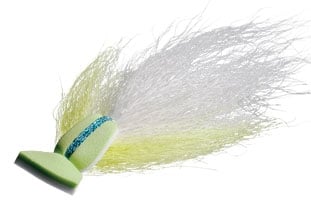
Jack Gartside’s Gurgler ranks among the greatest surface flies of all time. It is simple to tie, uses readily accessible materials and is deadly effective. A glance through any commercial fly catalog reveals Gurgler variations for topwater stripers, backcountry snook and freshwater bass, and even skating versions for steelhead.
One of the Gurgler’s chief virtues is its versatility. It falls somewhere between a popper and a slider. Sporting a prow of foam sheeting, it can be retrieved gently, creating a quiet wake as it slides half submerged along the surface. A solid yank, however, causes the lip to spit water in all directions. Few, if any, flies move so easily between slider- and popper-type presentations.
Another advantage of the Gurgler is how easily it lifts and casts. Poppers are notoriously taxing, but Gurglers are neither bulky nor heavy. As a result, Gurglers are far less wind resistant than poppers and can be cast with ease. And Gurglers have no cupped face or downward-tilting appendage digging into the surface of the water, so they glide easily off the surface on a backcast.
But to me, Gurglers shine most from a tying perspective. In many respects, they are more purely flies than many poppers and sliders. There is no balsa wood to carve or foam to sand. Rather, like traditional streamers, Gurglers remain mostly feathers and hair, but with a shell back and a thin foam lip. Because of this, Gurglers can be made to emulate baitfish and other prey better than almost any other popper-style fly. Yet they still reap the benefits of a popper’s noise and buoyancy.
Browse through Gartside’s website, www.jackgartside.com, and you’ll see Gurglers that imitate skinny sand eels, crabs, shrimp, bunker, worms and herring, with profiles ranging from long and skinny to short and fat, and everything in between. The tails and bodies are made from saddle, fur, marabou, chenille and pretty much anything else because the pattern adapts so easily to any desired shape or action.
Enter the Bucktail Deceiver
That adaptability led to the birth of the BTD Gurgler. Bob Popovics’ Bucktail Deceiver (chronicled by Lefty Kreh in the July/August 2005 issue of FFSW) is one of the truly great profile flies of all time. Comprised of nothing more than bucktail, the BTD is pure shape and taper, a natural for combining with the mechanical advantages of a Gurgler.
While the BTD has evolved considerably since first debuting in Popovics’ highly acclaimed book, Pop Fleyes, the essence of the fly remains the same. It is constructed of a series of concentric, 360-degree collars of bucktail placed judiciously along the hook shank. A natural taper is achieved through progressively shorter and more closely compacted collars of bucktail. The result resembles the lines of a real baitfish, with a long, tapered tail flaring gently out to a bulkier midsection and head.
Like the Gurgler, the BTD is also endlessly flexible; it can be made to resemble sand eels, squid, herring and virtually any other fishy shape. The most captivating version I ever saw was a dark-purple Mullet BTD tied by Popovics. It was hefty, and true to its mullet inspiration, it was conspicuously wide when viewed from the front. The head wasn’t cylindrical but more like an oval laid on its side. The resemblance to a mullet’s head and shoulders was uncanny. As Popovics explained, the width helped support the fly high in the surf.
I learned from that fly that collars of bucktail can be distributed in any shape and plane on a hook shank. Once the noose of thread traps a given collar, a tight squeeze from top to bottom with the thumb and forefinger of the nonthread hand squishes the hair sideways, yielding a flat plane of bucktail almost like parallel wings. Side-to-side pressure squeezes the hair up and down like a tall but thin butterfish or bunker.
An exaggeratedly flat, wide version of Bob’s fly makes for a great BTD Gurgler combination. When tied like an elongated pancake – with a long, straight tail transitioning to widely flared shoulders – the bucktail presents a big, girthy image from underneath. The effect looks almost like a floating flounder but with more of a teardrop, baitfish shape. Applying a Gurgler shell back keeps most of the pattern in or close to the surface so that the fish-eye view remains a solid, wide profile. Plus, the Gurgler lip lets you make as much or as little noise as you want.
Because of the absorbent bucktail and the weight of the hook bend, the rearmost bucktail collars sit mostly submerged, at a 45-degree angle, while the head and prow stay on top. With each strip, the tail bobs up to the surface and then sinks slowly on the pause. Because the frontmost bucktail collars are so widely flared, they stream back and to the sides on the strip and then billow outward on the pause, breathing with life and movement.
And because this wide, flat creature uses only sparse bucktail collars and foam sheeting, it is far lighter and easier to pick up and cast than any comparably sized popper. Experiment with different tail materials for added length. But however long you choose to go, flare those collars, as they are the key to the pattern’s unusually large and lifelike profile.
Materials
Hook: Saltwater long-shank (Daiichi X472 or Mustad S74SZ)
Thread: Unifine mono
Tail and Body: Bucktail
Shell back: Two sheets of Sticky Back Foam glued together
Cincher: Bodi-Braid
| Step 1: Attach bucktail at the hook bend, a quarter of the way up the shank. The second application should reach about three-quarters the length of the first. After distributing the second bunch of bucktail 360 degrees around the shank in loose thread wraps, pinch the hair top and bottom with your left thumb and forefinger to squeeze it out to the sides as you cinch down the thread with your right hand. | ** |
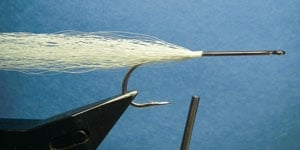
| | **Step 2: Fasten some Bodi-Braid on top of and trailing back over the bucktail, and then tie in a triangular piece of doubled foam sheeting at its very tip, letting the foam angle forward over the hook eye. | **
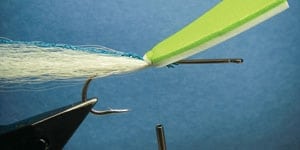
| | **Step 3: Flip the hook over in the vice and attach progressively shorter and more widely flared collars of bucktail along the shank, again squeezing tightly top to bottom as you cinch down the hair. The harder you pinch the hair, the more it will flare. | **
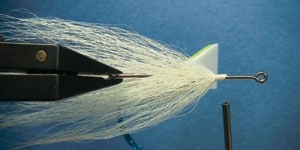
| | **Step 4: Complete the bucktail applications with a contrasting color and shorter and more widely flared “wings” of bucktail. Note that the frontmost collars barely reach the hook bend.|
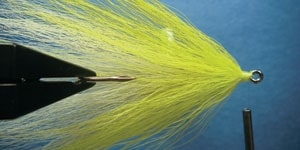
| | Step 5: Flip the hook in the vise again and tie down the front of the foam over the bucktail just behind the hook eye. Pull the Bodi-Braid over the foam to snug the whole assembly down, and tie and trim the braid in the crease of foam left by the thread wraps. Post some thread wraps in front of the foam lip to angle it upward, and trim lip to the desired shape.|
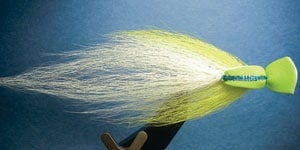
|









